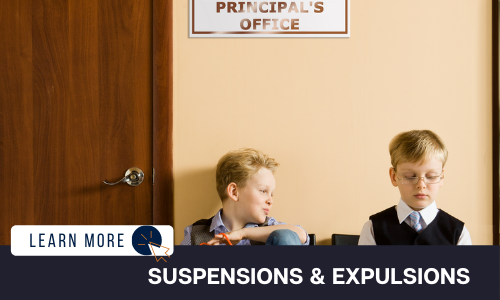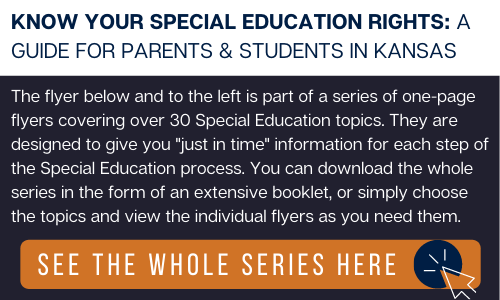Suspensions & Expulsions
 |
 |
PDF Version: Suspensions & Expulsions
PDF Version: Full Guide of all 30+ Flyers (Compiled as a Booklet)
Versión en Español en Formato PDF: Suspensiones y Expulsiones
What is a suspension?
Suspension is when your child is taken out of the place where they usually learn. Suspensions are supposed to happen only because your child’s behavior was not allowed in the school code of conduct. A suspension can be for part of a day or for a full day. The school can send your child home or to another place in the school building. They are both suspensions. If your child is sent home, that is called out-of-school suspension or OSS. If they are suspended at school, that is called in-school suspension or ISS. Schools must document every time a student is suspended.
The Individuals with Disabilities Education Act (IDEA) lets the school suspend your child even though they have a disability. However, the school cannot suspend your child for more than 10 days for something that happened because of your child’s disability. Partial days count as a full day.
Once your child has been suspended for more than 10 days, this is considered a change in placement. This means there needs to be an IEP (Individualized Education Program) meeting. Sometimes, these 10 days do not have to be in a row. A change in placement can also happen if there is a pattern of suspensions. A pattern of suspensions may exist if the suspensions are close together, depending on the total number of days your child has been suspended. Your child’s behaviors must show a pattern of same or similar behaviors to show that as a change in placement is needed.
An in-school suspension does not count toward the 10 days if the child is getting educational services and continues to work on their IEP goals.
What is an expulsion?
Expulsion is when your child is taken out of school for a long period of time for behaviors at school. It is supposed to happen only because this behavior was not allowed in the school’s code of conduct rules.
If the IEP team determines that your child’s behavior happened because of their disability, your child cannot be expelled. This is called a manifestation of the child’s disability. Here is an example: A child has a behavioral health disability that sometimes causes them to act out in ways that would violate the school’s code of conduct. If the acting out was caused (or manifested) by the child’s disability, the child cannot be suspended. You have the right to what is called a manifestation determination review (MDR). At the MDR, the IEP team, including you and your child, will decide if the behavior happened because of your child’s disability. The team will also decide if the school did not follow your child’s IEP or behavior intervention plan.
See more: What is a Manifestation Determination Review?
If your child has an IEP, they still need to be educated while they are out of school. Your child needs to continue to learn what other children are learning and must progress on the goals in his or her IEP. It is up to the school leader and your child’s special education teacher to decide how this will happen. But, it must happen.
Are there exceptions to these rules?
If your child brings a weapon or illegal drugs to school or to a school event, the school can still suspend or expel your child even if the behavior was a manifestation of their disability. They can also do this if your child seriously injures someone else at school.
Does the school still have to give my child services while they are suspended or expelled?
Starting on the 11th day of suspension or expulsion, the school still needs to educate your child while they are out of school. These requirements are only for children who have an IEP for a disability. It is up to the school leader and your child’s special education teacher to decide how the services will be provided.
How can I advocate for my child?
It is best practice that the school work to prevent suspending or expelling your child. If you know that your child might be having challenges with behavior at school, you can advocate for your child. Try to advocate for your child before they get to 10 suspensions. Look closely at your child’s IEP. Ask yourself these questions:
• Does the IEP talk about your child’s behaviors?
• Does the IEP talk about ways the teachers can help your child reduce any challenging behaviors or learn
new behaviors that are acceptable?
If your child has behavior challenges and the IEP does not fully address or prevent the behaviors from worsening, you can ask for an IEP meeting. You can also ask the school to do a functional behavioral assessment (FBA) and create a behavior intervention plan (BIP). If your child already has a BIP, and behaviors are still occurring, then changes might need to be made to the BIP.
See more: What are FBAs and BIPs?
Do these suspension and expulsion rules apply to my child with a disability if they don’t have an IEP yet?
Yes, if the school knows or suspects your child has a disability through one of these three ways: 1) you have expressed in writing to your child’s principal or teacher that your child needs special education and related services; 2) you have requested an evaluation of your child; 3) your child’s teacher or other school staff expressed concern about your child’s behavior to the a school leader, such as a principal or special education director.
Sources & Additional Resources:
Kansas Special Education Process Handbook. Chapter 13. Kansas State Department of Education.
Kansas Compilation of School Discipline Laws and Regulations. United States Department of Education.
.png)





